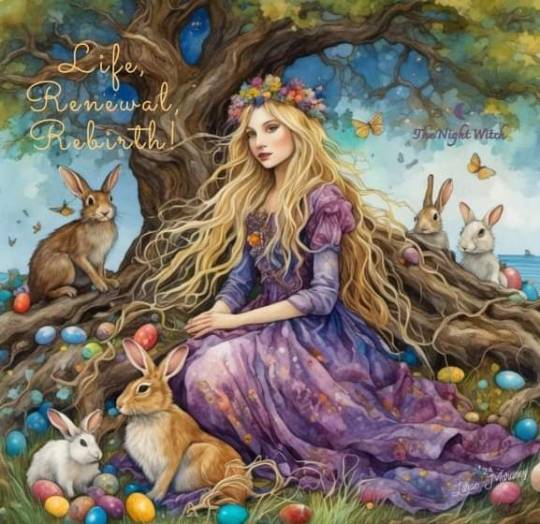#ostera
Text
Okay here’s the last of the bunny slippers. The theme here is one size fits all does not fit all. Cumulus’s Ostara gifts are a bit divisive. Either way they’re all asking why they had to wake up so early for this. Thanks for all who voted on Mountain’s animal. Maybe just maybe I’ll draw him in the other ones…




#I hope rains face reads as fuck my life don’t ever wake me up earlier than noon ever again#mountain is game always but he eepy#Dew is mad cause Swiss suggested she get him a kids sized next time#dewdrop ghoul#rain ghoul#mountain ghoul#the band ghost fanart#namelessghouls#ostera#midnight moth draws
79 notes
·
View notes
Text



Playing with some spring colour vibes for Ostera 🐰🌷✨🥚🐣🌸
#Ostera#spring#spring equinox#illustration#monsters#artists on tumblr#monsterdoodles#design#flowers#good vibes
4 notes
·
View notes
Text





Sisters™️
🖤 Ostera and Eleri🌻
I did the @saruin milkshake challenges (Ostera (they/she) is using v1 & Eleri (she/her), v2) and I think I found my new favorite simbz 🥰
It's funny how Ostera turned out goth, my personal style, while Eleri turned out sunshine-y like the beebread brand lol. Anyway, these half alien, half demon girlies are my life now
16 notes
·
View notes
Text

Art Fight attack for ChaoticTired, of their jellybean dragon named Ostera! I'll never get tired of space themed creatures.
13 notes
·
View notes
Text
{I love all the witchblrs getting a head start on the Spring Equanox but it's still very much Midwinter guys x3}
{Though I admit during the day here where I live it does sometimes feel a little like spring ♡}
{Their early-birdness has me thinking on my plans for spring as well! I guess it's just in the air right now ~ How magical °.○}

#wheel of the year#my path#eclectic witch#eclectic witchcraft#shaman#shamanism#witchcraft#magic#magik#shaman path#witchblr#witches of tumblr#spring#ostera#ostara#midwinter#spring equinox
4 notes
·
View notes
Photo

Blessed Ostera, witches! Or happy spring equinox to the rest of you! #ostera #altar #spring #springequinox #blessedostera #osteraaltar #firstdayofspring https://www.instagram.com/p/CqB92gHrM4k/?igshid=NGJjMDIxMWI=
1 note
·
View note
Text
also @ everyone who said that harry was perfect
you're so valid for that but im so sorry thats not technically true
#newt ooc#Haryan Ostera has never done anything wrong in his life but there is something so deeply wrong with him
3 notes
·
View notes
Text
the way there's more easter content than tdov content on my dash today is upsetting lol
#🙃#also pagan Ostera - good#christian/catholic nonsense? no thank u#celebrating seasons good#sky man zombie revivial day... no thank u
0 notes
Text
Tulip Tree Farm and Garden by Silver RavenWolf

View On WordPress
#Easter#Easter Basket#Easter Bunny#Pagan#Spring#Spring Equinox; Ostera; Silver RavenWolf#Wicca#Wiccan
0 notes
Text
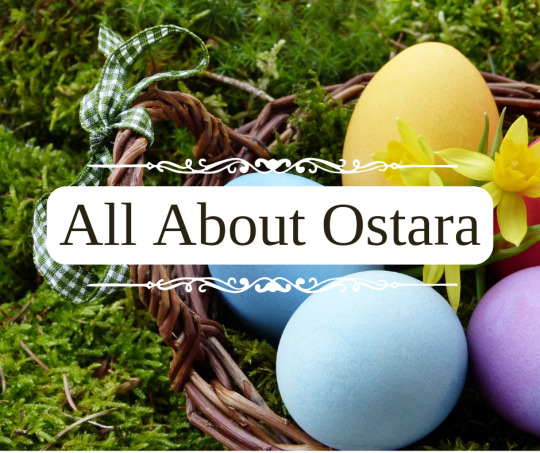
All About Ostara
In this context, Ostara is simply the name for the modern pagan celebration of the spring equinox, celebrated in the Northern Hemisphere around March 19th, or by some on the first full moon after the spring equinox. It is considered a Germanic holiday, but we'll talk a little about the different Goddesses associated with the holiday Ostara, as well as the history and where we're at today with our findings.
Unfortunately, there is not much historical text about the holiday Ostara or the associated ancient holiday Eostre, with the earliest known text being from an English monk from the 7th century, Venerable Bede. In his texts, he states that the rough equivalent of the month of April was dedicated to the Goddess Eostre and called Eosturmonath, but that was about all it mentioned.
Monks like Bede back in the day had orders to Christianize pagan traditions in order to slowly convert pagans to Christianity in the least-resistant way, which often meant adopting their festival dates, names of feasts, and whatnot, which was the purpose of mentioning this holiday in his texts in the first place.
Back in the day, the written reoccurant date of Easter had been debated since it began, as the Ressurection date was hard to nail down. Everyone just knew it happened in spring, so different regions celebrated it at different times. But, scholars believe the Christian church most likely saw that there were date overlaps in pagan celebrations, the Ressurection, and Passover as well, and decided to announce Easter Sunday would always fall on the sunday after the first full moon of the spring equinox, following popular pagan lunar traditions. They also adopted the new name from Eostre, cleverly combining the current pagan celebrations around rebirth and the sun into their own holiday traditions, in order to convert people to their religion, while also uniting their own people to celebrate on one date.
Although at one point these were all different celebrations, the Christian church did a very good job of combining and converting the pagan celebrations into their own, enmeshing them for life in history books and making it hard for modern day scholars to distinguish the origins of the pagan holidays seperate from the Christian church's.
After that, the next set of text with a reference to the holiday Ostara or Eostre came over a thousand years later during the Romantic period in 1835, by one of the Grimm brothers, Jacob, while he talked about mythology. In his work, he bridged Eostre with it's Germanic counterpart, Ostera or "Easter" as we know it today, and with the Goddess Ostara. In medieval Germany, they celebrated Ostarun in the month of Ostarmanoth, which gave way to the modern feast of Ostern ("Easter") today. He used these overlaps and more to claim that the two holidays and even Goddesses were most likely one historically
Just like with Grimm, there is mostly just speculation based on language, names, celebrations, etc. In modern-day society, it seems the holidays and Goddesses/Gods of Ostara, Eostre, and Easter have all been mashed up together from bridging multiple pagan religions with Christianity and struggling to seperate it again when we have almost no historical texts to help, since everything way back in the day was based on oral tradition.
As for the Goddess Eostre, who was supposedly a Goddess of fertility and light, she was so rooted in the region surrounding her that it was easier to adopt her namesake for the new Easter holiday (that enmeshed the series of Christian holidays) rather than rebrand under something Christian. According to Bede, her feasting was held in the month of April and celebrated spring. But that's all he mentioned, so her actual traditions have been lost to time, with only speculation to go off of.
After that, Grimm tried to link her with the Goddess Ostara, but we have no historical texts saying she is the same. Nowadays, the only mentions of the Goddess Eostre is with new-age pagan Wiccan practices where they, too, seemed to have linked her with the Goddess Ostara. Historically, it is most likely that the Goddess Eostre is a region-specific Goddess, as she was worshipped in Southeastern England by Anglo-Saxons, and that's where we see the oldest versions of her name referenced in text.
As for the Goddess Ostara, according to Grimm, she seems to have been the more wide-spread form of the Germanic Goddess Eostre, instead of region-specific, and he was the one who first translated her name to Ostara. This is the first historical text we have mentioning Ostara as a Goddess and not just a holiday, which means they (Eostre and Ostara) are technically one in the same, since Grimm was the one who translated the Goddesses name to German in the context that we use today.
In terms of associations with the newly translated Goddess Ostara, the first known reference of rabbits with Ostara in writing was mentioned in a mythology text written by Adolf Holtzmann in 1874 where he related the German tradition of the Easter Hare with Ostara by claiming the symbolism of 'the hare' was also probably sacred to the Goddess.
Afterwards, In 1889, an issue in the Journal of American Notes and Queries talks about the Germanic Tradition of the Easter Hare (gifting cotton stuffed flannel bunnies to children along with Easter eggs) and the story behind it, stating that "The hare was originally a bird, and was changed into a quadruped by the Goddess Ostara; in gratitude to Ostara or Eastre, the hare exercises its original bird function to lay eggs for the Goddess on her festal day." But that is as far as we've gotten in tracing it in texts.
Most likely, oral tradition has reigned supreme throughout history, and different narratives have surfaced about the origins of the symbolism with Ostara and rabbits and eggs and other things, so it's hard to know for certain what is "true" to celebrating the Goddess and holiday Ostara and what isn't.
In summary, based on the limited evidence that we have surrounding history on this holiday and deity(ies), you should feel free to celebrate Ostara in a way that is meaningful to you, especially since there is much overlap with multiple religions and practices. I did my best to round up the most commonly accepted ways to celebrate, the symbolism, and more related to the holiday and Goddess Ostara/Eostre.
Ostara Associations:
Colors - white, green, yellow, pink, purple, pastels
Food - eggs, fresh greens, dairy products, hot crossed buns, lamb, asparagus, honey, berries
Animals - hares/rabbits and song birds, baby animals, snakes
Items - decorated eggs, lillies, daffodils, tulips, crocuses, dandelions, lavender, other flowers, lemongrass, thyme, red clover, birch trees, seeds
Crystals - aquamarine, amethyst, rose quartz, moonstone, fluorite, amazonite, clear quartz
Other - fertility, renewal, dawn, spring, balance, joy, growth
Ways to Celebrate Ostara:
hold a feast, especially on the full moon after the equinox
plant seeds
connect with nature or go on a walk
decorate eggs
prepare your altar for spring
make a cotton stuffed flannel rabbit
decorate for spring with greenery and flowers
cleanse and clean your home
welcome the dawn and sunrise
bake hot crossed buns
create something
#ostara#eostre#eastre#easter#pagan#wiccan#witchy#witch#witchcore#witches#witchcraft#witchblr#witch community#goddess#gods#holiday#sabbat#sabbath#equinox#moon#full moon#magick#magic#spell#spellwork#cleansing#spiritualism#spirituality#spiritual#baby witch
36 notes
·
View notes
Text



Long day of Ostera activities today and making candles. Frejas golden tears candle is now up on the shop. Hope all of my tumblr family is well and everyone had a great day. - Lokeanlady
#lokean#norse pagan witch#norse polytheism#norse deities#norse pantheon#Freja#freyja deity#freya goddess#heathenry#asatru#small business#deity candle#deity communication#actually autistic
5 notes
·
View notes
Text



Early Vintage Frohe Ostera Happy Easter Cardboard Lidded Box w Rabbit ebay kingsburyfarm
0 notes
Text
Traditions of men
Lol ya no thank you.. I like the 4th of July I guess.. ishtar, ostera, solstices, sun worship, days of ritual, any day can be a new year lol.. feasts of beasts, astrology, year of this and year of that,, everyone only ever has one birthday, why rejoice in the deaths of saints, and lives of snakes,, months of recognition of divisions and pain..
Do u ever think it's all distractions from the sabbath day, how uve all been lead astray.. how everything has been twisted.. from God from your faith.. I always say why would they go to such lengths to have u believe God is fake, why would they go to such lengths to seperate,, why would they need to deceive you if God's not real.. its because if u even sought out God, to know or even to disprove,, u would know God is more real than u could imagine, head of days, from the beginning to the end, gets very personal with just you..
Lol all these other days are what's fake,, magic isn't real, ritual is kinda retarded, it's all for the simple minded, petty beliefs for slaves, noneone has any powers, God is just in control of shit, can seem a miracle.. wake up u little fuks it's time to grow up.
0 notes
Text




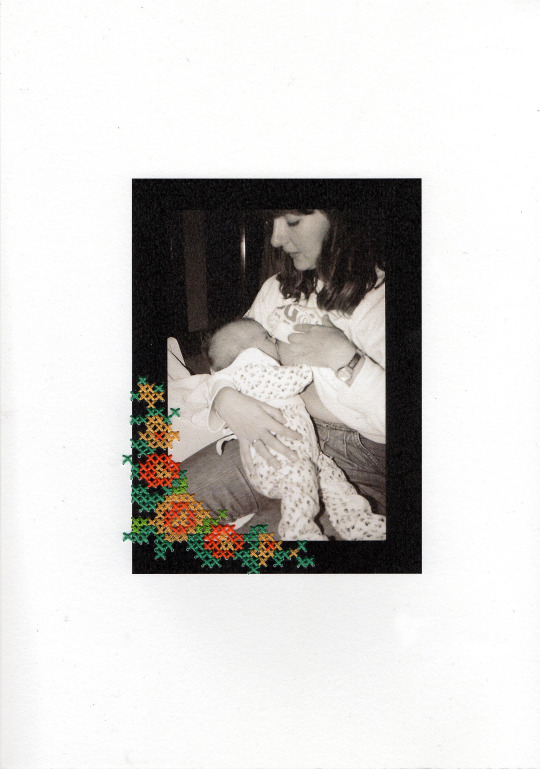

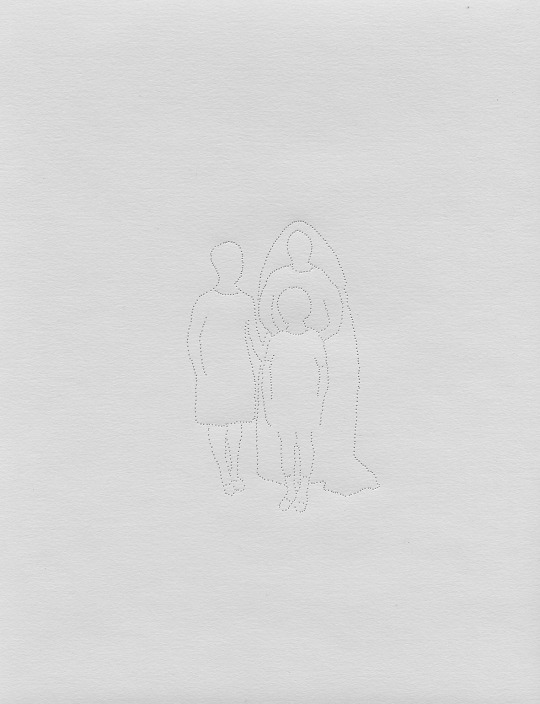
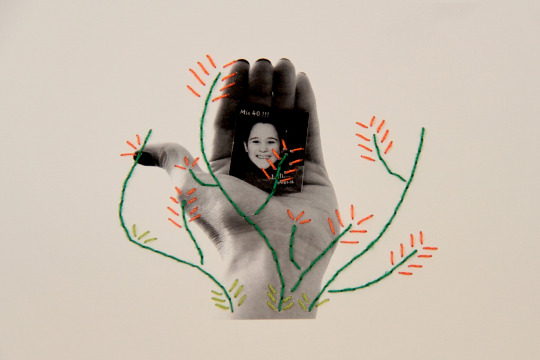


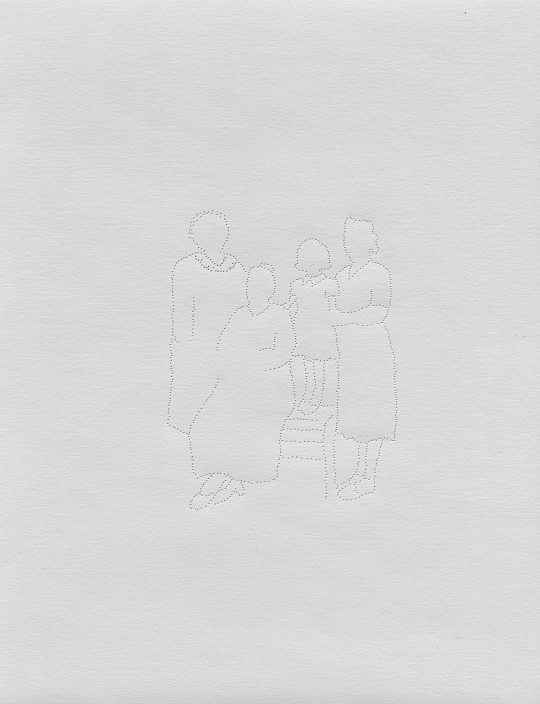


2018
OLA 5/ Paulina Antelo, Carolina Soriano, Gabriela Muzzio y Florencia Giacobbe
PAULINA ANTELO
Nació en Rosario en 1986. Licenciada y Profesora en Bellas Artes por la Universidad Nacional de Rosario, estudió fotografía analógica y laboratorio blanco y negro en el ISET Nº18. Se formó con Gabriela Muzzio y Gabriel González Suárez.
Desde el 2014 a la actualidad trabaja como docente de arte es una escuela primaria e integró el equipo de trabajo de EspacioLab Programa de arte, ciencia y tecnología que funciona en el Complejo Astronómico Municipal de la ciudad de Rosario (CAM), dedicado a la producción e investigación en formato de laboratorio.
Es ayudante de las Cátedras “Laboratorio I” a cargo de la docente y artista Verónica Orta y de “Proyecto II” dictada por el artista Gabriel González Suárez ambas de la carrera de Bellas Artes, Universidad Nacional de Rosario. Miembra del colectivo de artistas y trabajadoras gráficas rosarinas “Cuadrilla Feminista”.
Se formó en la Universidad de Guanajuato, México y en la École nationale supérieure.
CAROLINA SORIANO
Nace en la ciudad de Rosario en el año 1974. Se recibió de Técnica Superior de Fotografía en el Instituto ISET nro 18. Se especializó en Prácticas de Laboratorio en la Escuela de Artes Plásticas Manuel Musto y en el Taller de Gabriela Muzzio. Realizó diferentes Talleres de especialización fotográfica, entre ellos con Gisela Volá, Agustina Triquel y Romina Resuche en Buenos Aires y con Cecilia Lenardón, Andrea Ostera y Nancy Rojas en Rosario. Realizó talleres de procesos antiguos de fotografía, Colodión Húmedo y Cianotipo. Participó de diferentes muestras individuales y colectivas. Docente de los talleres de Fotografía Estenopeica en su Estudio La Revelada. Trabaja de manera independiente en 2 ONG. Mamá de Santino.
GABRIELA MUZZIO
Nace en Marcos Juárez en 1969. Estudia fotografía en Rosario desde 1990 y en 1996 inicia su formación en conservación de fotografía. Desde 2000 se dedica a investigar sobre los procesos fotográficos antiguos y materiales sensibles. Ha realizado muestras individuales y colectivas en centros culturales, galerías y museos del país y el exterior. El 2014, publica su primer libro Los abrazos editado por Editorial Municipal de Rosario. “La memoria de los otros” Mención Especial LXVII Salón Nacional de Rosario 2014, “Natura Signa” Salón Nacional Rosa Galisteo 2016, “Seda” Salón Nacional Emilio Caraffa 2018, Concurso Artes Visuales Fondo Nacional de las Artes “S/T” 2019 Mención Especial,” Officinalis” Bienal de fotografía El ojo salvaje, Paraguay. Participa de la Residencia espontánea Curadora y de Nido errante Edición Vaqueros, Argentina. Desde 1999, es docente del Taller de fotografía de la Escuela Municipal de Artes Plásticas Manuel Musto. Desde 2005, es miembro del equipo del programa de recuperación del Archivo fotográfico del Museo de la ciudad de Rosario.
FLORENCIA GIACOBBE
Nació en Rosario, en 1976. Es fotógrafa e historiadora. Participó de diferentes colectivos fotográficos como Apacheta y La Vista Gorda, el primero dedicado a la fotografía documental y el segundo a registrar las distintas expresiones artísticas de la ciudad, especialmente la murga uruguaya. Expuso, tanto en forma individual como colectiva, en distintas muestras del país y Uruguay. Actualmente es integrante de La Bemba del Sur, colectivo político de talleristas que realiza prácticas educativas en las distintas unidades penitenciarias del sur de Santa Fe.
1 note
·
View note
